
I haven’t met an organization yet that isn’t interested in saving money and optimizing their cloud spend. That’s where Azure Reserved Instances (RIs) come in. Properly leveraged, Reserved Instances, particularly Virtual Machine Reserved Instances can result in some significant savings. In fact, it was the topic of discussion at one of our recent Daymark Cloud Clinics where our technical cloud consultants offer free technical training and tips on a wide range of Azure and Office 365 features.
Reserved Instances Explained
Let’s start by explaining exactly what Reserved Instances are. As an Azure customer, you commit to using a resource for a number of years (typically one to three years) and in return, Microsoft gives you a significant discount. This helps Microsoft with accurate capacity planning for their regions while also providing customers with an incentive to make a long-term commitment. And the savings can be significant, up to 72% on VMs.
Clearing up Confusion
Let’s start with a common misconception. The name “Reserved Instance” makes most of us think there is a reservation or contract that is assigned and dedicated to a particular VM. While this is how it worked previously, that is not exactly how Reserved Instances work today. It’s better to think of a Reserved Instance as a coupon. If you are running a resource that matches the reservation discount, then the cost is reduced. The key point is that reservations are not assigned to specific VMs. And the focus of this blog is on VMs because these tend to be the most common type of RI.
Terms
One of game changers for Azure reservations came in September of 2019 when Microsoft enabled monthly payments for RIs. This eliminated the requirement to pay a large, upfront lump sum to start the reservation. Monthly payments offer a lot more flexibility and budgeting ease, allowing organizations to spread the payments across the entire term – which is the next important point.
How long do you want the contract to last? It’s a big decision. If you go into Azure and just start up a VM it’s usually just running in pay-as-you-go mode. Pay-as-you-go can be a good option if you are running a limited time test or need a system that is not powered on 100% of the time. A great example of this is a utility server you perhaps only need a few hours a week. You may turn that on as needed and turn it off when not in use. In that case it’s a cost-effective use of the VM.
However, for most other situations where you need to run a VM constantly, a Reserved Instance could be a great option. When purchasing a Reserved Instance, you will need to make a decision on the length of term. As mentioned, the most common terms are one or three years. There are a number of factors that come into making a decision on term - most of which will have to do with your company’s strategic goals and plans.
A five-year reservation is also an option, but not common. The only VM size currently with this option is the HBv2 which is a VM optimized for applications driven by memory bandwidth. It’s unclear if Microsoft will continue to offer five-year reservations for other resources.
Purchasing Reserved Instances
In addition to the multiple terms, there are also virtual machine types and Instance Flexibility Groups. In order to understand how to apply a reservation, you need to understand the definitions so that we can get to the level of an Instance Flexibility Group.
All VMs in Azure fall into one of the six VM types listed in the graphic below. For our example, we’ll focus on a VM which lies in the “General Purpose” type.
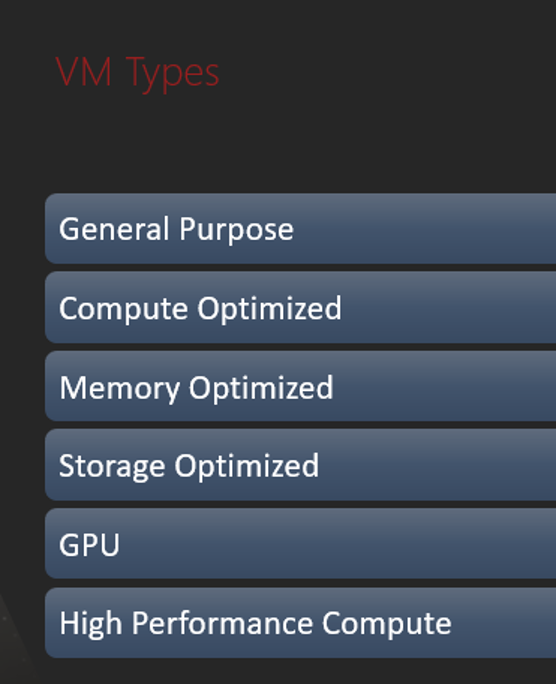
In the General Purpose type, there are several series. All of these have their own configurations with their individual pros and cons.
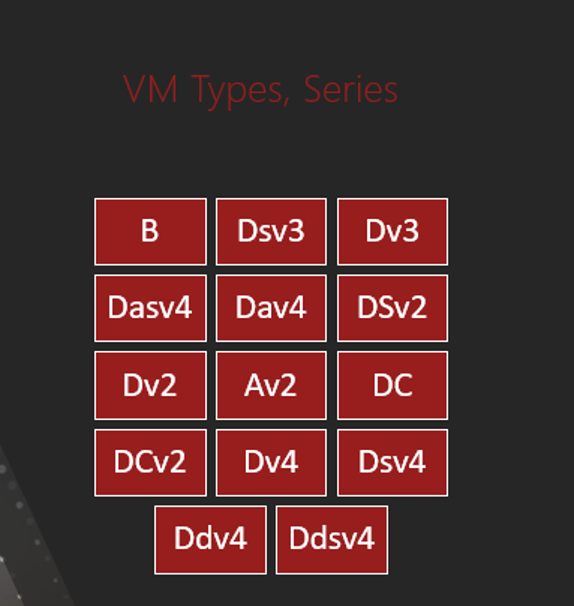
The next example will be on a VM in the DSv2 series. As you go down this list, each VM has more resources and is a more expensive VM to run.
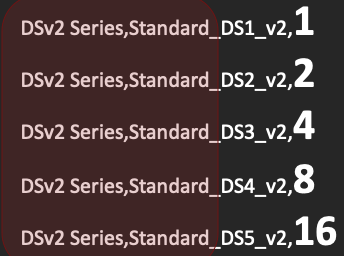
Microsoft introduced Instance Flexibility Groups in 2018. This was another big shift because with this change, customers are able to purchase any VM size in this group and have it apply to any other VMs in the same Flexibility Group. This enables a more flexible use of reservations.
Understanding Ratios
Ratios make this a reality. With ratios, you don’t have to deploy the exact VM size to get the benefit of a purchased RI. Other sizes can benefit from the discount. This is what makes the flexibility groups so powerful because the ratios are the value that determine how the purchased resource will apply.
For example, if you purchase one DS2 as a reservation, that has a ratio of 2. This means this reservation can cover the full cost of a DS2. For the sake of comparison, with a DS1 VM, two of those VMs can be supported by the same reservation. If we were to upgrade the DS2 to a DS3, we would find that the reservation would only work on half of the VM cost. The math is here to show that Azure allows you to resize your VMs and still get some or all of the discount.

Ratios and Flexibility Groups should be top of mind when planning your VMs. Flexibility Groups have ratios assigned at the VM level and they allow you to tune your VM and still keep a discount. However, the more you spread VMs across Flexibility Groups, the more management time it can take to tune.
Region
Region is another decision you will need to make with every RI purchase. It’s one of the constraints put onto a reservation. If you purchase a reservation for the East US Region you will not be able to use that reservation for a VM in any other U.S. region. This is a key tool that Microsoft uses to determine their capacity planning for each region.
Savings over Time

Discounts vary based on Type, Term, and Region. This example shows total cost incurred for DS2v2 in the East US for Pay as you go, 1-year, and 3-year terms. This also assumes paying each term as a lump sum rather than spreading it out over months. Here’s how the savings stack up:
- 1 year with two renewals delivers 58% savings
- 3 years delivers the greatest savings clocking in at a 72%!
Please note: These are estimated savings based on pricing at the time of this writing.
Key Considerations
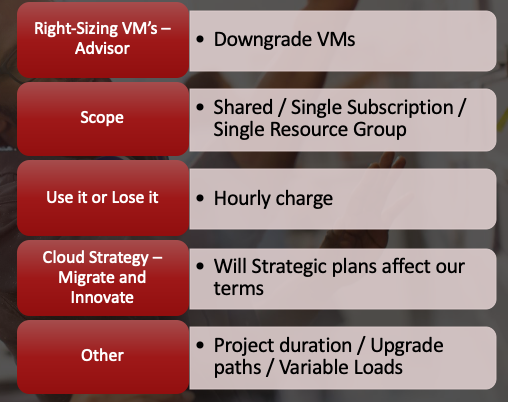
Right Sizing:
We covered Azure Advisor in another Cloud Clinic webinar. It’s important to note that one should review Advisor’s suggestions for resizing of VMs prior to purchasing RIs to ensure your VMs are not over provisioned. But It’s critical to note that Azure Advisor only covers a single subscription at a time. So, if you have a few subscriptions, be aware this could require a bit of legwork to collect suggestions.
Scopes:
Reservations can have one of the three different scopes. Shared, Single Subscription or Single Resource Group. Shared is the most commonly used scope since it encompasses multiple subscriptions. In certain chargeback scenarios you may want to use Single Resource Group or Single Subscription. It all depends upon how you want to structure your costs.
Use it or Lose it:
Reserved Instances are a “use it or lose it” plan. It’s an hourly charge and it doesn’t bank any unused time. If you don’t use it for the full hour you will lose it. This is a key concept to consumption of these resources.
Strategic Goals:
Is your long-term strategy to migrate or innovate? If your company is embracing the cloud there could be future justifications to move workloads from VMs to PaaS. If there is a big push away from IaaS to PaaS then you may want shorter terms on your VM’s.
Other Considerations:
The “Other” category includes a list of miscellaneous items that may, or may not, apply to your organization with questions like:
- Does my project have an end date?
- Does my upgrade path require development systems that will overlap with production and could the new hardware require tuning to find the appropriate Instance Flexibility Group?
- Do we have any variable loads on these systems? If so, has this system been under load for the 30 days for Advisor to come up with an educated answer?
These are just a few of the questions to keep in mind.
Strategies for Success
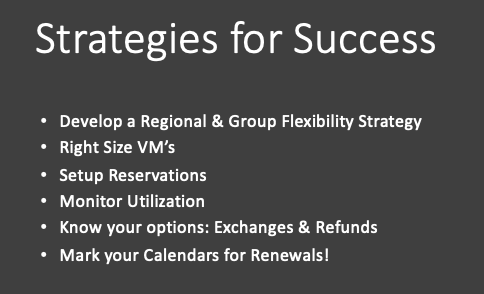
I hope these tips have provided a deeper insight into how to make Reserved Instances work for you and avoid unnecessary costs. Remember to keep in mind:
Regional & Group Flexibility Strategy
- You want to develop a regional and Instance Group Flexibility strategy. This will help you get ahead of management issues. For example, there are policies that only allow your company to deploy VMs in certain regions so that reservation purchases can have the best chance of utilization.
Right Size VMs
- Work with Azure Advisor and the business to ensure your VMs are not wasting resources. But also, that performance is appropriate for your users’ needs.
Setup Reservations
- Purchase and assign your reservations with consideration to flexibility groups/ regions/ and scopes
Monitor Utilization
- Periodically check to make sure you are fully utilizing your VMs and understand your options for exchanges and returns. This will reduce any undue loss of monthly expenses.
Calendar Renewals
- Mark your calendars for renewal dates. There is an automated warning, but you want to give yourself plenty of time to modify your reservation strategy. Don’t put yourself is an unnecessary time pressure situation.
If you’re ready to take the next step and need help, please contact me. We can set up a conversation on many of the Azure professional services we provide including:
- Stepping into the Cloud
- Price Calculator Walkthrough
- Azure Migrate Analysis
- In the Cloud Tune up
- Cost Analysis and Recommendations
I also encourage you to sign up for our remaining Cloud Clinic session on December 10, 2020 when we’ll cover Continuous Access Evaluation. These complimentary training webinars run from 12:00-12:45, so grab your lunch and join us! Sign up here.



